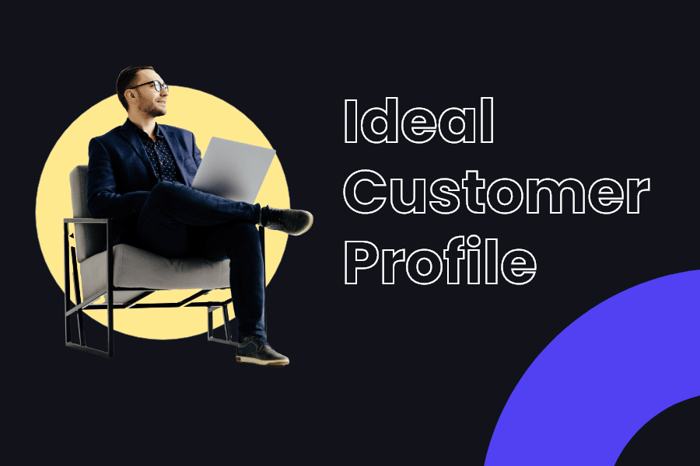Inbound Marketing Sales & Marketing Strategy Delivery
How to Define Your Ideal Customer Profile for Account Based Marketing
09/28/2020 • 3 min read • Written by Sara Sprenger
Table of Contents
For countless years, marketing teams attracted new leads by casting a wide net and hoping for a bite. In some scenarios, they did this without little thought, in a tactic that makes most marketers squirm: “spraying and praying.”
Obviously, this is not true for every marketer, but the prevalence of these strategies led to account-based marketing (ABM). ABM focuses on generating revenue from a carefully crafted list of target accounts, instead of a generalized buyer persona. Since coming onto the inbound marketing scene, ABM has exploded in popularity, mainly due to its successes.
Before you run off to your boss with content ideas for an ABM strategy, you first need to define your ideal customer profile (ICP). Without it, you won’t have a reference to create your first list of target accounts, and you won’t be able to curate the right marketing material at the appropriate time.
Here’s an overview of setting up an ICP.
What Is An ICP?
As noted, an ICP is your ideal client profile or a description of the kind of company you want to work with, or you believe it is a perfect fit for your company. So, instead of saying, “We want to work with X Company,” think more along the lines of, “Our team works well with a B2B company with 100 employees, located in the Southwest region of the U.S., have a large marketing department who are skilled at automation software, and make at least $1 million in revenue annually.”
To develop an example like that, you’ll need to look for specific company-wide and personal characteristics.
Company Characteristics to Look For
You may already be able to point out similarities between companies you currently work with to whom you deliver your best work. Are they all B2C? Are they located in the same geographic location? Find out for sure by zeroing in on these characteristics:
- Industry or business vertical
- Annual revenue
- Budget (particularly for your type of solution)
- Location
- Technology stack and their maturity with it
- Size of their customer base
- Overview of their sales process
- How they research vendors/third party suppliers
- How they onboard new vendors or services
- Their growth profiles
- Their competitive environment
- The number of employees – company-wide and within the key departments you’d be working with. Note: when you’re looking at individual employees, look at what skills they need to perform their job, who they report to, what they do, and how their performance is measured
Personal Characteristics to Look For
Not only do you want to look at a company as a whole, but you’ll want to look for certain traits among the people within that company you’ll be working with. After all, you want to market to the decision-maker in a target account, and you’ll want to have a good relationship from Day 1. Ask yourself:
- What are the personal characteristics of your best current clients?
- What makes your working relationship with a point of contact positive?
- What clients do you enjoy working with, and why?
- What do you value in people in general - your coworkers, your management, your clients?
- Is there any client, person, or company that you are not excited to engage with?
- For certain individuals (and the company as a whole), what are the challenges and pain points they face that would drive them to hire you?
How to Find This Information
If you’re overwhelmed about locating these details, don’t be. There are several methods to getting the data you need to define your ICP. They include:
- Interviews with similar clients, companies, target personas you’ve identified in the past
- Websites of target accounts you’ve considered, but haven’t defined completely yet
- Doing a roundtable with your departments to ask them what they believe makes a good fit for the company – try asking them the personal characteristic’s questions from above!
- Your CRM and marketing automation platforms - contact info, emails, meeting notes, and more
Forums and industry research like reports or documents published by similar clients or ones you’ve identified - Customer review sites like TrustPilot, Google, G2
Quiz Yourself: How Optimized Is Your Marketing Strategy?
Get Started
Now that you have some guidance on crafting your ideal clients, you can start outlining yours. You can then begin narrowing down your target accounts, and before you know it, you’ll be off to the ABM races. For any help with ICPs, messaging, or overall tactics, don’t hesitate to reach out.
By: Sara Sprenger
As the Chief Marketing Officer of Lynton, Sara is a jack of all trades. She thrives on diving into diverse areas like marketing, web development, and integrations, all with the goal of helping clients unlock their full potential. She's passionate about tackling challenges, solving complex problems, and embracing new experiences. When she's not using HubSpot to solve the world, you’ll likely find her being a Floridian at the beach or spending quality time with my dog, Maple Leaf.
You May Also Like

Inbound Marketing
How to Find and Reach Your Target Audience
Discover how to identify and reach your target audience effectively. Boost your marketing efforts with our actionable tips an...
Keep Reading
Inbound Marketing
What to Know About ICP vs. Buyer Personas for ABM
Ideal client profiles and buyer personas? Read more about their subtleties and how they can accelerate your account-based mar...
Keep Reading
Inbound Marketing
How to Create an Ideal Customer Profile
Learn how to create an Ideal Customer Profile (ICP) to enhance your marketing strategy and target the right companies for you...
Keep ReadingSubscribe Today

